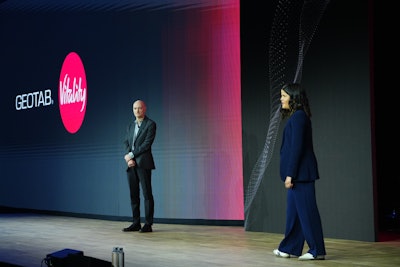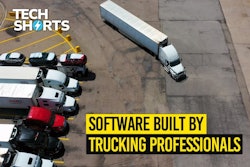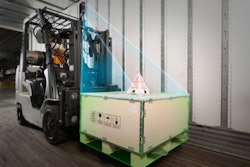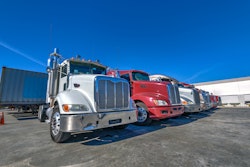
Fleets have long struggled with backlash from drivers over installing dash cameras – both road- and driver-facing. The reasons behind drivers’ aversion to the technology runs the gamut with privacy being a popular defense.
Some trucking companies swear by cab-facing cameras – that it’s the only way to get whole the picture – while many have received so much driver detestation that they’ve opted instead for forward-facing only.
Geotab has rolled out a new solution in its safety suite that eliminates the need for both.
The telematics provider announced the launch of its first AI-powered hardware device Wednesday at its user conference, Geotab Connect in Orlando. GO Focus, a road-facing sensor that aims to enhance fleet safety while addressing privacy and compliance concerns, does record video when AI detects a critical moment, but it has no microphone and no removable storage.
“We think that GO Focus is a very low-cost, privacy-centered way to get 80%, 90% of the benefit of a camera system without the cost and without the privacy problems, so it's a good entryway,” Geotab CEO Neil Cawse said during a media interview Wednesday following his keynote session in which the product was revealed.
The sensor’s AI detects the leading collision risk of following too closely, often caused by distraction, fatigue or phone use.
If a collision occurs, the forward-facing sensor automatically records and uploads video, ensuring critical incidents are documented. Drivers can also manually trigger recordings using a dashboard-mounted button, providing video evidence for exoneration when needed.
[RELATED: Getting drivers on board with driver cameras]
Cawse said cameras are about targeting poor behavior and the outcome of poor behavior in the cab, and he thinks Geotab can do that without the expense of a full camera solution.
“If we, in analyzing the way you drive, notice you are not maintaining a healthy following distance, we know you are distracted and you're not driving well,” he said. “If you think about the heart of what an accident is, your following distance becomes negative. It's that simple. So in essence, we see this as really a great place to fit in, where we think we can make cameras ubiquitous without the downsides of cameras, which are cost and privacy.”
Mike Lasko, vice president of safety at sister companies Boyle Transportation and Skelton Truck Lines, previously told the CCJ that his company, which has road-facing cameras, has no plans to implement driver-facing cameras in its over-the-road fleet because of privacy concerns, especially because the fleet has many women drivers. But he also said his fleet doesn’t need driver-facing cameras because it has advanced driver-assistance systems (ADAS) and telematics.
Cawse said Geotab ingests ADAS data from its OEM partners to supplement safety scoring for customers whether they have a GO Focus device or not.
GO Focus is augmented with context like accelerometer data, location, traffic situations, if a vehicle is on an on-ramp or changing lanes.
“We have all of that,” Cawse said. “What we were missing was what does the rest of the roadway look like while you’re driving, and GO Focus supplements that final point.”
A new partnership
Cawse said some fleets want to monitor the driver for things like drinking coffee or cellphone use, but Geotab Vice President of product management Sabina Martin said the needle needs to move from drivers just being monitored to having them “walk the talk” and take action to change their behavior.
That is why Geotab has formed a joint venture with behavioral health platform Vitality Group. Geotab Vitality aims to improve driver safety and wellbeing by bringing together telematics data and behavioral science.
Vitality Deputy CEO Francois Theron said during the keynote Wednesday that vehicles have more safety technology, but severe incidents continue to rise. Driver behavior, he said, is what needs to change. That’s no easy task, but Vitality has seen achievements. Its Vitality Drive insurance program has experienced 55% fewer claims and significantly lower road fatalities compared to national averages.
Drivers can measure their performance against anonymized insights from Geotab’s extensive dataset of over four million vehicles, categorized by vocation and vehicle class. Personalized nudges and rewards encourage steady progress, leading to a 15% improvement in driving behavior within the first 30 days.
Every week, drivers receive personalized driving goals, based on their past performance, to encourage consistent progress and improvement. Drivers are given a driver status level, which reflects their risk rating relative to the overall population of drivers who are similar to them. Drivers get points for improvement and earn rewards like gift cards.
This is a shift from the traditional industry model of penalizing poor driving habits.
[RELATED: Tampering with technology: how fleets can prevent drivers from disabling safety systems]
“From a safety perspective, for a long time in our industry, to monitor driving habits and behavior you would rely on accelerometer data and measuring things like harsh braking, cornering or maybe speeding … (with) traditional scorecards or count the number of events and come up with an arbitrary score, and whoever had the lowest score is who would be coached from a driving perspective,” Martin said. “But if you think about that, it’s not very scientific in determining how that impacts your chance of getting into a collision, which is ultimately what you're trying to avoid.”
A scientific approach
Geotab’s new predictive collision risk models started with a single fleet.
Martin said Geotab was working with a fleet that used a driver scoring mechanism that had plateaued. In a study with the fleet, Geotab’s model found that a group of its drivers who had been classified based on its scoring mechanism as “good drivers” were collision risks, and it was missing out on coaching opportunities.
“We've been able to use collision data as well as our telematics data to train a model to understand scientifically what are those risk factors based off of their driving habits that are going to impact their likelihood of getting into collision in, say, the next 100,000 miles,” Martin said. “It removes the bias; it looks at actual collisions and past trends to be able to do that, and it also allows us to benchmark drivers who operate in similar conditions, whether it's rural versus city, different weather conditions, etc, bringing additional context into the equation, instead of just looking at their individual behavior.”
Mike Branch, Geotab vice president of data and analytics, said the joint venture with Vitality also operates at that same predictive collision risk model.
And it’s all part of what Cawse called a “revolution” where AI, telematics and data meet to become an effective road safety tool that will spread from the commercial sector to the consumer sector.
“The revolution is that you do not get accurate enough data from an app on a phone or from basic telematics in a regular consumer vehicle. In a commercial vehicle, there is a high incentive to deploy advanced telematics like Geotab, so the quality and level of data that we have to feed the models that allow us to do the benchmarking,” he said. “This is the new world order because now you can scientifically prove that if I speed more than five kilometers an hour above the speed limit, or if my following distance is too close, this is how much I'm increasing my risk.
“And I can take real steps towards reducing risk as opposed to hypothetical because we can test it on all the data,” he added. “It's exciting.”













